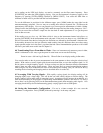8
4. FRONT PANEL DESCRIPTION AND INITIAL SET UP
4.1 General - Before turning on your HP3586 be sure it’s configured for the right input power, usually
115VAC. Also be sure the filter on its back panel is clean, if not remove it and clean with only soap and
water. The filter should be cleaned after every 720 hours of operation.
In the following sections and chapter you’ll see capital letters in brackets like [AUTO]. These identify
buttons used to control the instrument or enter data. The front panel of a HP3586 is broken into groups or
sub panels, which we’ll refer to in this chapter to aid in locating individual displays and controls.
Additionally, on the front panel you will see some buttons with a second label below the button or two
labels on the button like buttons near the keyboard, these are dual function buttons. Ones with two labels
on the button will select the proper function automatically by the button that is previously pushed, like if
you push [FREQ] the instrument knows MHz, KHz, or Hz apply instead of the other labels like –db or -db.
The ones with labels below and above the button are shifted button. On the same panel you will see an
unlabeled colored shift button with a light on it. When it’s light is on, the lower label of the dual-purpose
adjacent buttons will apply. Also buttons with lights will have their function on when their light is on.
Plug you HP3586 into AC power and the STANDBY annunciator should light, next turn on your HP3586
by pressing [POWER]. It will first perform an auto calibration for about 5 seconds. If a ERR or CE with a
number is displayed on the LH front panel read out there has been an error during calibration, refer to
Appendix A for a listing of errors and suggested corrective action. The [AUTO CAL] button light should
be on but you can turn off auto cal at any time by pressing this button, but for now leave it on. After the
initial power up and auto cal the instrument should default to the low distortion-measuring mode with a
range setting of 10db auto. During the following sections we will describe the front panel controls. Since
the instrument will default to the selective low distortion level measuring mode when first it’s powered up
you may not need to perform all the described button pushing commands but just confirm that the
instrument is set up as described.
During the following sections of this chapter, have your HP3586 available in front of you to find the
described controls and LED displays.
4.2 Measurement/Entry Group - On the upper LH is the measurement/entry sub panel, which is used
for displaying the power or voltage measurements and their units on a LED display. The measuring range
and range full scale range value is set using it’s buttons. Set the range by pressing [10db] and the full scale
range limit by pressing [AUTO] for the automatic mode. The analog meter reads the relative level of
signals within the selected 100db or 10db range. With the 100db and auto settings this meter will work as
a relative signal strength meter to aid in frequency tuning. Press [dbm] to have the display read in dbm
units. A dbm annunciator should now light to indicate the units are shown in dbm. The [OFFSET] button
is used to subtract values placed in an offset register that will be subtracted from level values computed by
the instrument to correct or normalize displayed level values. We will discuss this feature later, for now
leave it off. Other buttons we’ll discuss later during some of the examples.
4.3 Frequency/Entry Group - On the upper RH side of the front panel is the frequency/entry sub
panel. This panel will usually display the frequency that the instrument is tuned to. It will display during
frequency entry frequencies being entered by the instrument’s keyboard in KHz or Hz. This frequency will
be the center RF frequency of the selected band pass filter except when in the SSB channel measurement
modes. On all models this panel can select a LSB or USB, side band channel for measurement using the
two channel buttons with a funny symbol I can’t show with Word. The left button is for LSB while the
one on the right is for USB. A counter button is provided to start the frequency measurement counter
system. Only the A and B versions have the SSB entry frequency selection buttons. The carrier button
should be on when in one of the SSB channel modes and tuning a SSB signal. This changes the display to
read SSB carrier frequency instead of filter center RF frequency. Even when their lights are on, the tone


















